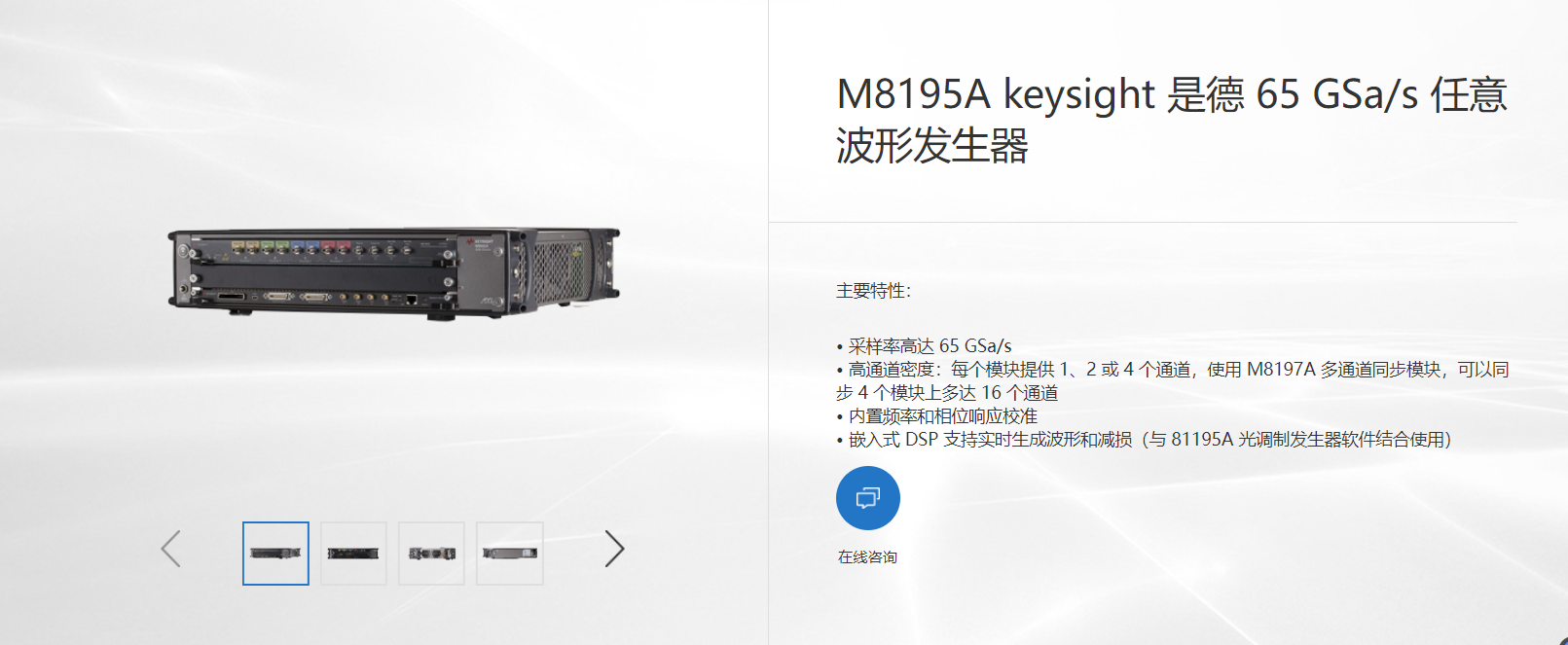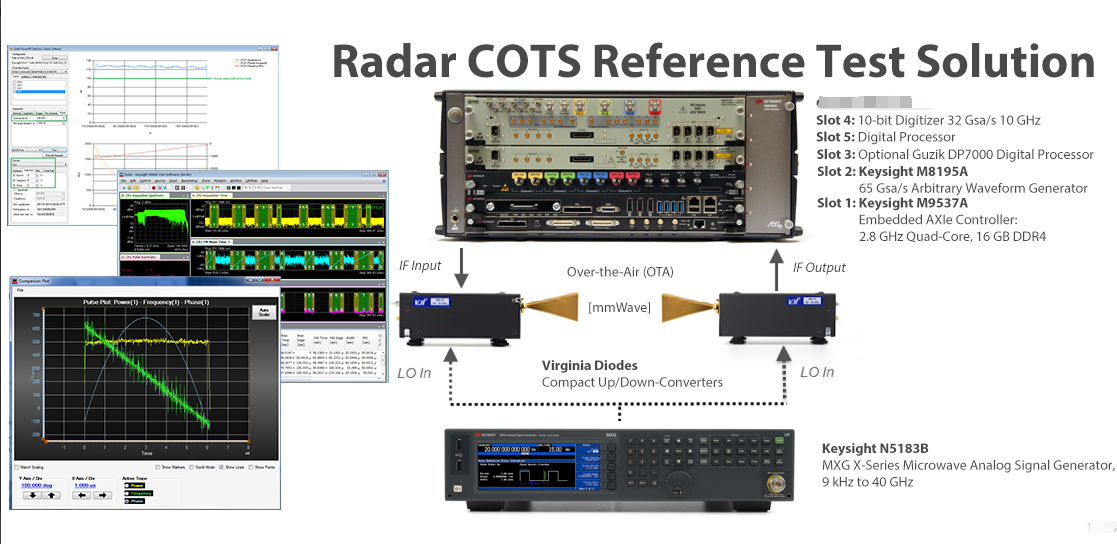How to Generate Various Types of Radar Signals Using the M8195A Arbitrary Waveform Generator
The M8195A Arbitrary Waveform Generator is a high-performance signal source that can generate arbitrary waveforms with a sampling rate of up to 65 GSa/s and an analogue bandwidth of 25 GHz. It can be used to simulate a variety of complex signals, such as radar signals, optical communication signals, digital RF signals and so on. In this paper, we will introduce the methods and precautions for simulating radar signals using the M8195A Arbitrary Waveform Generator.

Radar (Radio Detection And Ranging) is a technology that uses radio waves for detection and ranging, which is widely used in military, aviation, navigation, meteorology, geology and other fields. The basic principle of the radar system is: the transmitter transmits a certain frequency and power of radio waves to the target direction, the receiver receives the radio waves reflected back from the target, and processes and analyses them, so as to obtain the target's position, speed, shape and other information.
Radar signal is the radio wave transmitted and received in the radar system, which determines the performance and function of the radar system. There are many types of radar signals, such as pulse signals, continuous wave signals, frequency-modulated continuous wave (FMCW) signals, phase-coded signals, Doppler-shifted signals, and so on. Different types of radar signals have different characteristics, advantages and disadvantages and are suitable for different application scenarios.

There are three methods to simulate radar signals using the M8195A Arbitrary Waveform Generator: baseband generation method, IF generation method and direct RF generation method.
- Baseband Generation Method: This method generates baseband signals (i.e. low frequency or DC signals) internally or externally in M8195A, and then modulates the baseband signals to the desired carrier frequency through the internal or external modulator of M8195A, so as to generate radar signals. The advantage of this method is that the parameters of the baseband signal, such as amplitude, phase, frequency, pulse width, etc., can be flexibly controlled; the disadvantage is that additional modulators and filters are required, which increases the complexity and cost of the system.
- IF Generation Method: This method generates an IF signal (i.e., an intermediate frequency signal between baseband and carrier) either internally or externally in the M8195A, and then upconverts the IF signal to the desired carrier frequency via the M8195A's internal or external upconverter to generate a radar signal. The advantage of this method is that it can reduce the number of modulators and filters, which reduces the complexity and cost of the system; the disadvantage is that it requires higher quality of the IF signal, such as phase noise and harmonic distortion.
- Direct RF Generation Method: This method generates the radar signal at the desired carrier frequency directly inside or outside the M8195A without any modulation or frequency conversion process. The advantage of this method is that it can maximally maintain the quality of the radar signal, such as phase noise, harmonic distortion, etc.; the disadvantage is that it requires high performance of the M8195A, such as the sampling rate and analogue bandwidth.

When using M8195A Arbitrary Waveform Generator to simulate radar signals, you also need to pay attention to the following aspects:
- Waveform memory settings: The waveform memory of M8195A can store multiple waveforms, and each waveform can have different sampling rates, lengths and repetition times. When simulating radar signals, it is necessary to reasonably allocate and switch the waveform memory according to the characteristics and demands of the signals to achieve continuous or intermittent signal output.
- Impact of clock jitter: Clock jitter refers to the instability of the clock signal, which leads to changes in the frequency, phase and amplitude of the signal, affecting the quality and accuracy of the signal. When simulating radar signals, the effect of clock jitter needs to be minimised by the following methods: using a high-quality external clock source, using the internal clock source of the M8195A, using the clock distribution function of the M8195A, and so on.
- Synchronisation of multiple signals: In some application scenarios, it is necessary to generate multiple radar signals at the same time, such as multi-beam radar and multi-target radar. In this case, it is necessary to ensure the synchronisation between multiple signals, including time synchronisation and phase synchronisation. the M8195A provides a variety of synchronisation functions, such as trigger synchronisation, clock synchronisation, marker synchronisation, etc., which can achieve accurate synchronisation of multiple signals.
The M8195A Arbitrary Waveform Generator is a powerful simulation tool that can be used to simulate various types of radar signals. When using M8195A Arbitrary Waveform Generator to simulate radar signals, it is necessary to select appropriate parameters and equipment according to different methods and pay attention to some special considerations and techniques to improve the simulation effect and efficiency.

The M8195A Arbitrary Waveform Generator is a high-performance signal source that can generate arbitrary waveforms with a sampling rate of up to 65 GSa/s and an analogue bandwidth of 25 GHz. It can be used to simulate a variety of complex signals, such as radar signals, optical communication signals, digital RF signals and so on. In this paper, we will introduce the methods and precautions for simulating radar signals using the M8195A Arbitrary Waveform Generator.

Radar (Radio Detection And Ranging) is a technology that uses radio waves for detection and ranging, which is widely used in military, aviation, navigation, meteorology, geology and other fields. The basic principle of the radar system is: the transmitter transmits a certain frequency and power of radio waves to the target direction, the receiver receives the radio waves reflected back from the target, and processes and analyses them, so as to obtain the target's position, speed, shape and other information.
Radar signal is the radio wave transmitted and received in the radar system, which determines the performance and function of the radar system. There are many types of radar signals, such as pulse signals, continuous wave signals, frequency-modulated continuous wave (FMCW) signals, phase-coded signals, Doppler-shifted signals, and so on. Different types of radar signals have different characteristics, advantages and disadvantages and are suitable for different application scenarios.

There are three methods to simulate radar signals using the M8195A Arbitrary Waveform Generator: baseband generation method, IF generation method and direct RF generation method.
- Baseband Generation Method: This method generates baseband signals (i.e. low frequency or DC signals) internally or externally in M8195A, and then modulates the baseband signals to the desired carrier frequency through the internal or external modulator of M8195A, so as to generate radar signals. The advantage of this method is that the parameters of the baseband signal, such as amplitude, phase, frequency, pulse width, etc., can be flexibly controlled; the disadvantage is that additional modulators and filters are required, which increases the complexity and cost of the system.
- IF Generation Method: This method generates an IF signal (i.e., an intermediate frequency signal between baseband and carrier) either internally or externally in the M8195A, and then upconverts the IF signal to the desired carrier frequency via the M8195A's internal or external upconverter to generate a radar signal. The advantage of this method is that it can reduce the number of modulators and filters, which reduces the complexity and cost of the system; the disadvantage is that it requires higher quality of the IF signal, such as phase noise and harmonic distortion.
- Direct RF Generation Method: This method generates the radar signal at the desired carrier frequency directly inside or outside the M8195A without any modulation or frequency conversion process. The advantage of this method is that it can maximally maintain the quality of the radar signal, such as phase noise, harmonic distortion, etc.; the disadvantage is that it requires high performance of the M8195A, such as the sampling rate and analogue bandwidth.

When using M8195A Arbitrary Waveform Generator to simulate radar signals, you also need to pay attention to the following aspects:
- Waveform memory settings: The waveform memory of M8195A can store multiple waveforms, and each waveform can have different sampling rates, lengths and repetition times. When simulating radar signals, it is necessary to reasonably allocate and switch the waveform memory according to the characteristics and demands of the signals to achieve continuous or intermittent signal output.
- Impact of clock jitter: Clock jitter refers to the instability of the clock signal, which leads to changes in the frequency, phase and amplitude of the signal, affecting the quality and accuracy of the signal. When simulating radar signals, the effect of clock jitter needs to be minimised by the following methods: using a high-quality external clock source, using the internal clock source of the M8195A, using the clock distribution function of the M8195A, and so on.
- Synchronisation of multiple signals: In some application scenarios, it is necessary to generate multiple radar signals at the same time, such as multi-beam radar and multi-target radar. In this case, it is necessary to ensure the synchronisation between multiple signals, including time synchronisation and phase synchronisation. the M8195A provides a variety of synchronisation functions, such as trigger synchronisation, clock synchronisation, marker synchronisation, etc., which can achieve accurate synchronisation of multiple signals.
The M8195A Arbitrary Waveform Generator is a powerful simulation tool that can be used to simulate various types of radar signals. When using M8195A Arbitrary Waveform Generator to simulate radar signals, it is necessary to select appropriate parameters and equipment according to different methods and pay attention to some special considerations and techniques to improve the simulation effect and efficiency.








